Kaffir plum, Wild plum
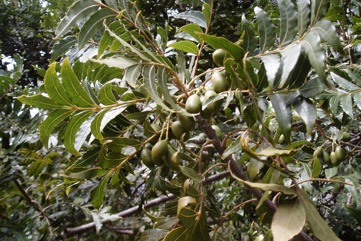
A tropical and subtropical plant. It can stand moderate frosts. It adapts to most soils. It needs reasonably good drainage. The extensive root system can block drains. It can grow in arid places. It grows in Miombo woodland in Africa. It suits hardiness zones 9-11. Wittunga Botanical Gardens. Brisbane Botanical Gardens.
Also known as:
Amagwenya, Ingwenya, Mmedibibi, Umgonyogonyu, Umgwenya, Umngwenya
Edible Portion
- Fruit
Where does Kaffir plum grow?
Found in: Africa, Australia, East Africa, Eswatini, Fiji, Hawaii, India, Kenya, Mozambique, North America, Pacific, Puerto Rico, South Africa, Southern Africa, St Helena, Swaziland, United States, Zimbabwe
Notes: There is only one Harpephyllum species.
Growing Kaffir plum, Wild plum
Cultivation: Plants can be grown from seed. It is best to plant fresh seed. The seeds are removed from the flesh and planted 2 cm deep. Stored seeds should be soaked in warm water for 24 hours before sowing. They germinate in 7-12 days. Plants can be grown from semi-ripe cuttings.
Edible Uses: The fruit are eaten fresh. It is enjoyed especially by children. They can be dried and have a pleasant, salty flavour. They are also used for wine and jelly or jam.
Production: Trees produce fruit in 4-5 years. A fruit weighs about 5 g.
Nutrition Info
per 100g edible portion| Edible Part | Energy (kcal) | Protein (g) | Iron (mg) | Vitamin A (ug) | Vitamin c (mg) | Zinc (mg) | % Water |
|---|---|---|---|---|---|---|---|
| Fruit | 41 | 0.7 | 1.2 | - | 70.7 | 0.9 | 87.5 |
Kaffir plum, Wild plum Photos

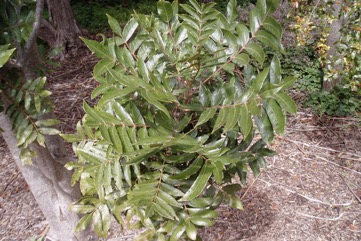
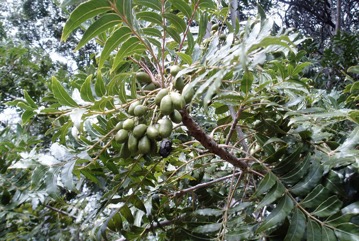
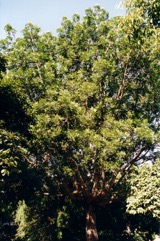
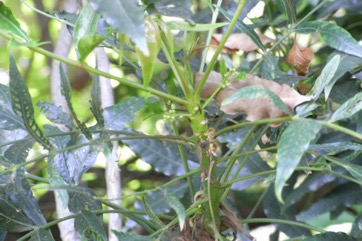
References
Ambasta, S.P. (Ed.), 2000, The Useful Plants of India. CSIR India. p 257
Bodkin, F., 1991, Encyclopedia Botanica. Cornstalk publishing, p 537
Cundall, P., (ed.), 2004, Gardening Australia: flora: the gardener's bible. ABC Books. p 672
Dharani, N., 2002, Field Guide to common Trees & Shrubs of East Africa. Struik. p 118
Etherington, K., & Imwold, D., (Eds), 2001, Botanica's Trees & Shrubs. The illustrated A-Z of over 8500 trees and shrubs. Random House, Australia. p 370
Facciola, S., 1998, Cornucopia 2: a Source Book of Edible Plants. Kampong Publications, p 10
Flora 27(1):349. 1844
Fox, F. W. & Young, M. E. N., 1982, Food from the Veld. Delta Books. p 72
Gouldstone, S., 1983, Growing your own Food-bearing Plants in Australia. Macmillan p 101
Hibbert, M., 2002, The Aussie Plant Finder 2002, Florilegium. p 119
INFOODS:FAO/INFOODS Databases
Jardin, C., 1970, List of Foods Used In Africa, FAO Nutrition Information Document Series No 2.p 141
Joffe, P., 2007, Creative Gardening with Indigenous Plants. A South African Guide. Briza. p 109
Long, C., 2005, Swaziland's Flora - siSwati names and Uses http://www.sntc.org.sz/flora/
Lord, E.E., & Willis, J.H., 1999, Shrubs and Trees for Australian gardens. Lothian. p 57
Lyle, S., 2006, Discovering fruit and nuts. Land Links. p 235
Martin, F. W., et al, 1987, Perennial Edible Fruits of the Tropics. USDA Handbook 642 p 13
Palgrave, K.C., 1996, Trees of Southern Africa. Struik Publishers. p 458
Palmer, E and Pitman, N., 1972, Trees of Southern Africa. Vol. 2. A.A. Balkema, Cape Town p 1195
Peters, C. R., O'Brien, E. M., and Drummond, R.B., 1992, Edible Wild plants of Sub-saharan Africa. Kew. p 48
Recher, P, 2001, Fruit Spirit Botanical Gardens Plant Index. www.nrg.com.au/~recher/ seedlist.html p 2
Rivero, J. A., y Brunner, B. R., 2007, Arborels frutales exoticas y poco conocidos en Puerto Rico. Universidad de Puerto Rico. p 12
Royal Botanic Gardens, Kew (1999). Survey of Economic Plants for Arid and Semi-Arid Lands (SEPASAL) database. Published on the Internet; http://www.rbgkew.org.uk/ceb/sepasal/internet [Accessed 25th March 2011]
Ruiters-Welcome, A. K., 2019, Food plants of southern Africa. Ph.D. thesis. Univ. of Johannesburg p 13
Schmidt, E., Lotter, M., & McCleland, W., 2007, Trees and shrubs of Mpumalanga and Kruger National Park. Jacana Media p 298
Shava, S., 2000, The Use of Indigenous Plants as Food by a Rural Community in the Eastern Cape: an Educational Exploration. Masters Thesis Rhodes University. p 65
Smith, A.C., 1985, Flora Vitiensis Nova: A New flora of Fiji, Hawai Botanical Gardens, USA Vol 3 p 458
Staples, G.W. and Herbst, D.R., 2005, A tropical Garden Flora. Bishop Museum Press, Honolulu, Hawaii. p 102
Swaziland's Flora Database http://www.sntc.org.sz/flora
Tredgold, M.H., 1986, Food Plants of Zimbabwe. Mambo Press. p 105
van Wyk, Be., & Gericke, N., 2007, People's plants. A Guide to Useful Plants of Southern Africa. Briza. p 44
van Wyk, Br., van Wyk, P, and van Wyk B., 2000, Photographic guide to Trees of Southern Africa. Briza. p 10, 174
Van Wyck, B., & Van Wyck, P, 1997, Field Guide to Trees of Southern Africa. Struik. p
van Wyk, B-E., 2011, The potential of South African plants in the development of new food and beverage products. South African Journal of Botany 77 (2011) 857–868
Venter, F & J., 2009, Making the most of Indigenous Trees. Briza. p 190
Wehmeyer, A. S, 1986, Edible Wild Plants of Southern Africa. Data on the Nutrient Contents of over 300 species.
Wilson, A. L. & Downs, C. T., 2012, Fruit nutritional composition and non-nutritive traits of indigenous South African tree species. South African Journal of Botany. 78:30-36
World Checklist of Useful Plant Species 2020. Royal Botanic Gardens, Kew